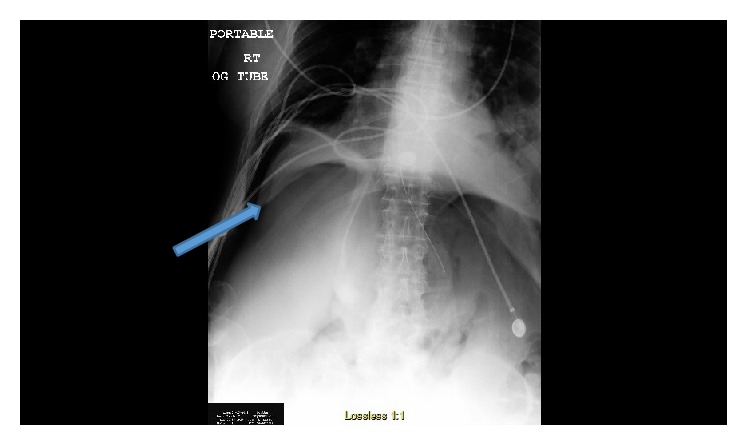Playlist
Show Playlist
Hide Playlist
Emphysema: Pathogenesis B
-
Slides ObstructiveLungDisease Emphysema RespiratoryPathology.pdf
-
Reference List Pathology.pdf
-
Download Lecture Overview
00:01 All right. So now if that's Centrilobular, let us now move into our second subtype. 00:06 This is pan Acinar. 00:08 What was the last time you heard of Pan. 00:10 Mitral regurgitation. 00:12 And you've heard of Pan. 00:13 Systolic. What does that mean? Throat. Pan means throat in general. 00:19 Now this is pan acinar Panasonic emphysema. 00:22 The entire acinus and secondary lobule are affected uniformly. 00:26 This pathology is primarily seen at the base of the lungs, which is a direct contrast to the apex involvement seen with central acinar emphysema. 00:34 Now this is a big problem. 00:36 How important is this? Quite why it take a look. 00:41 Most common homozygous. 00:43 What's that mean? Both genes have been affected in Caucasians. 00:48 One of the most common homozygous genetic mutations in Caucasians. 00:53 What are some of the other ones that you know of? You definitely know about down trisomy 21 and you know about cystic fibrosis chromosome seven. How popular are those? Unfortunately quite in the Caucasian population. 01:05 So what is this that we're talking about? Before you get into details, understand the concept. 01:11 Let's start from the start real quick. 01:13 Remember those neutrophils that were recruited when smoking. 01:16 What did they release that enzyme. 01:19 Good. It was a elastase wasn't it. 01:21 This elastase was then released. 01:23 And what is it that normally neutralizes the elastase. 01:26 Good. That's your alpha one antitrypsin and centrilobular. 01:30 There is no genetic mutation was there in Centrilobular. 01:34 What about panacea? Yes there is. 01:36 So there's absolutely nothing protecting the lung from the elastase. 01:41 So it comes from neutrophil. 01:42 Now I'm going to first give you a nonsmoker a nonsmoker who shows up with fev1 FVC ratio. 01:51 Decreased pulmonary function test. 01:54 Disney has taken place on chest x ray. 01:56 You find a barrel chest nonsmoker age there or maybe about 4545. 02:01 So without any smoking your patient is now gone into emphysema. 02:05 But this is the panacea type. 02:07 And with the panacea type, you know, well, you're thinking a Caucasian patient most likely alpha one antitrypsin deficiency deficiency. 02:16 So what is this gene? Well, look at the gene here. 02:20 Normally it's called py mm. 02:22 What's that Py stand for. 02:24 Protease inhibitor. 02:26 Hmm. What's a protease. 02:28 An enzyme. Which enzyme. 02:30 Oh the enzyme from the neutrophil. 02:32 Yep. That that enzyme from neutrophil. 02:34 What was that called. Elastase. 02:36 So now you have to know a few names don't you. 02:38 So that neutrophil releasing that proteolytic enzyme protease known as elastase and pi stands for protease inhibitor I think that's a beautiful name appropriately done. 02:49 Okay. So what happens now. 02:51 Well you pick up mutations. 02:54 What's homozygous mean. 02:55 Both genes for every Z that you pick up you have further deficiency of alpha one antitrypsin. You have both mutations taking place. 03:08 You have two z's. 03:10 What does that mean to you. 03:11 This is homozygous alpha one antitrypsin deficiency. 03:14 Wow. That means not a single alpha one antitrypsin is being produced properly. 03:21 Hmm. Why did I emphasize the term properly? You'll see why. 03:25 Okay, so now you have no proper amount of or properly formed alpha one antitrypsin. 03:32 So who wins this battle automatically? Elastase? Or are we done? No. What other organ is highly dependent on this protective mechanism? The liver. The liver is so. 03:43 Therefore in a patient pensioner this is a big deal with homozygous you know about homozygous for example there's a difference between sickle cell trait and sickle cell disease. What is sickle cell disease that's homozygous isn't it. 03:58 So that's hemoglobin S isn't it. 04:00 It's hemoglobin hemoglobin S anyhow. 04:03 So as there's no alpha one antitrypsin. 04:05 And so not only is the lung being damaged from from apex to base but as, as is the liver and with the liver, you're worried about this patient going on to what. 04:14 Cirrhosis. Nothing protecting it. 04:16 Now I'm going to walk you through this properly formed type of alpha one antitrypsin and why that's important to you clinically. 04:23 Childhood hepatitis evolving into cirrhosis in adulthood would reveal protein globulins. 04:30 Stop there. Okay. 04:31 From henceforth, when you think of the term hepatitis, do not think viral. 04:37 Only think about all the different reasons why you can have hepatitis, hepatitis, alcohol, hepatitis, autoimmune hepatitis, Nash, hepatitis, Wilson's disease, hepatitis O, viral hepatitis here, alpha one antitrypsin deficiency. 04:52 All that hepatitis means is inflammation. 04:54 That's it okay. 04:55 But many many many, many, many, many causes of hepatitis. 04:58 So as a child you were never. 05:00 Ever born as a homozygous. 05:01 You were never born with enzyme, so your liver is already damaged. 05:05 You called that hepatitis? Whew. With all that damage taking place, what's setting in fibrosis? Fibrosis. Fibrosis. Fibrosis. 05:12 Eventually, what are you going to result in? A type of micronodular. 05:15 Type of cirrhosis? Cirrhosis is my point. 05:18 And when you have cirrhosis taking place, I told you properly, you don't have properly formed alpha one antitrypsin. 05:25 What is an enzyme? A protein a protein is formed. 05:29 In what organelle? In your cell. 05:31 Good. Rough endoplasmic reticulum. 05:33 Okay, now my point is this. 05:34 So now you can't form an alpha one antitrypsin because of the deficiency enzyme deficiency genetic mutation. 05:41 But is the liver desperate enough to produce alpha one antitrypsin? It is desperate. 05:46 It needs it so that it can protect the liver and maintain homeostasis. 05:51 So it tries. 05:53 But when it tries, it produces what, a protein globule in the. 05:58 Read the full statement here. 05:59 Hepatocyte endoplasmic reticulum upon liver biopsy. 06:05 Is that clear? Why is our protein globule being formed. 06:09 Because you're trying to form who is. 06:10 The liver is trying to form your alpha one antitrypsin, but it doesn't produce properly. 06:14 So within your hepatocyte and endoplasmic reticulum, you end up finding a protein globule. That is the full picture of panacea and how it's strictly associated with your genetic mutation being homozygous. 06:27 Now, your patient here, I told you, was a nonsmoker at the age of 45. 06:32 Well, could you have a patient with panacea and this type of alpha one antitrypsin deficiency was a smoker? Sure. So if they're a smoker and they have alpha one antitrypsin deficiency homozygous type, how old do you think he or she is when they then present with penicillin or emphysema? 35. 06:50 That's crazy. That's ridiculously young to be developing such an issue with your lung and such. Okay, now a couple other things here. 07:00 It's a pair receptors where we are. 07:01 This is distal acinar emphysema. 07:03 What does it do? Results in destruction of the alveolar duct. 07:06 It may occur alone in combination with any of the above two types. 07:10 Referring to your well centrilobular or Penicillium. 07:14 When your patients are infected with parasitic emphysema alone, it usually results in spontaneous pneumothorax. 07:21 What does that mean? Okay, so the type that we just looked at earlier was the proximal type. And with the proximal type you're in the respiratory bronchiole. 07:29 Are we clear. Go back and take a look at the definition proximal. 07:33 With this you can have a centrilobular type of pattern without alpha one antitrypsin deficiency. But if there is alpha one antitrypsin deficiency that is panacea. 07:41 We just talked about all of this. 07:44 If the distal portion is affected now you're distal from the respiratory bronchiole. 07:48 Where are you? You're one step closer to the alveolar alveoli. 07:52 So affecting the alveolar duct and maybe even the alveoli. 07:55 Hmm. If that happens then you're weakening and weakening and weakening the parenchyma. 07:59 What may then happen. 08:00 Uh oh. Rupture. 08:02 Mm. We now rupture taking place along. 08:04 What happens? You've lost your negative pressure, right? Because anything outside of the lung, what happens to your pressure, it automatically becomes positive. Are we clear? What's your best analogy? Uh, when's your birthday? Well, during the birthday, maybe you got balloons. 08:21 If you didn't, then I'm sorry. 08:23 I don't know what to tell you, but anyhow. 08:24 So you know what a balloon is. 08:25 You're blowing it up. You're blowing it up. 08:27 You're blowing it up. That's your lung. 08:28 Okay. How do you keep it open? Well, as long as you have, uh, negative intrapleural pressure, you keep it expanded. 08:34 Are we clear? Then you take a pin. 08:36 You ever have this? Once. 08:37 You one of those maybe, uh, mischievous, uh, little, uh, little dudes or dudettes. 08:43 And what are you doing? You're going around popping balloons. 08:45 Bop bop bop bop. 08:47 All right, so this is what you're doing in spontaneous pneumothorax? That needle, you pop the balloon, what happens? A balloon, which is your lung collapses. 08:56 That's spontaneous pneumothorax. 08:57 That is the best method of explaining in simple terms as to what spontaneous pneumothorax is. 09:03 So when you have distal, your alveolar duct, which is undergoing massive destruction, please understand that you might then introduce spontaneous pneumothorax. 09:14 You then tell me as to what you can expect upon percussion of your chest. 09:19 Will it be tympanic or will it be dull? Your lung just collapsed, for Pete's sakes. 09:25 This is all empty. 09:26 So upon percussion it'll be thing. 09:29 Obviously I'm exaggerating, but it'll be tympanic. 09:32 Is that clear?
About the Lecture
The lecture Emphysema: Pathogenesis B by Carlo Raj, MD is from the course Obstructive Lung Disease: Basic Principles with Carlo Raj.
Included Quiz Questions
Which of the following gene mutations leads to the development of panacinar emphysema?
- PiZZ
- PiSS
- Pizz
- PiZz
- PiSZ
In addition to lungs, which of the following organs is affected in alpha-1 antitrypsin deficiency?
- Liver
- Spleen
- Kidney
- Heart
- Pancreas
Which of the following organelles accumulates protein globules in childhood hepatitis that progresses to cirrhosis in adulthood?
- Endoplasmic reticulum
- Nucleus
- Lysosome
- Golgi apparatus
- Vacuole
What is the composition of alpha-1 antitrypsin molecules?
- Protein
- Fat
- Mucin
- Carbohydrate
- Nucleic acid
Which of the following is a common complication of distal acinar emphysema?
- Spontaneous pneumothorax
- Pleural effusion
- Pneumonia
- Bronchiectasis
- Lung cancer
Which of the following statements is not true regarding emphysema?
- Centrilobular emphysema involves no alpha-1 antitrypsin production in the lung.
- Heterozygous type of panacinar emphysema has some levels of alpha-1 antitrypsin.
- Homozygous type of panacinar emphysema has no production of alpha-1 antitrypsin.
- Panacinar emphysema commonly involves the lower lobes.
- Centriacinar emphysema commonly affects the upper and middle lobes.
Which of the following cell organelles produces alpha-1 antitrypsin?
- Rough endoplasmic reticulum
- Lysosome
- Golgi apparatus
- Microtubules
- Nucleus
Customer reviews
5,0 of 5 stars
| 5 Stars |
|
2 |
| 4 Stars |
|
0 |
| 3 Stars |
|
0 |
| 2 Stars |
|
0 |
| 1 Star |
|
0 |
Very easy to understand Lectures. Well Explained. Liked it very much.
I would never get it without you, Dr. Raj! Thank you soooooooooooooo much!!!!!!




